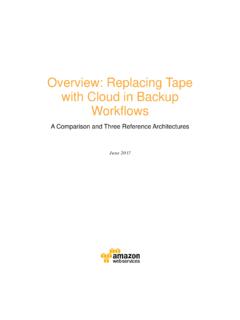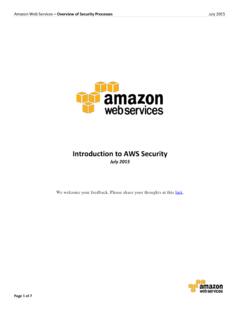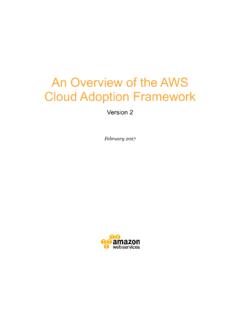Transcription of Backup, Archive, and Restore Approaches Using AWS
1 backup , archive , and Restore Approaches Using AWS Pawan Agnihotri AWS Certified Solutions Architect Professional Amazon Web Services November 2014 Amazon Web Services backup , archive and Restore Approaches Using AWS November 2014 Page 2 of 26 Contents Abstract 3 Introduction 3 Why Use AWS 4 backup and archive 5 Cloud Native 5 Snapshot Options for Amazon EBS 6 Creating Consistent or Hot Backups 7 Multivolume Backups 8 Backing Up Databases 9 Backups for Amazon Relational Database Service 10 backup and Recovery of the Amazon Machine Image (AMI) 11 On Premises 12 Hybrid 15 Cloud Paradigms 19 Protecting Configurations Rather Than Servers 19 Using Storage Fit for Purpose 21 Automating Infrastructure 23 Conclusion 23 Appendices 25 Terms 25 Partner Solutions 26 Amazon Web Services backup , archive and Restore Approaches Using AWS November 2014 Page 3 of 26 Abstract Over the past couple of years enterprise data has grown substantially, and the growth is accelerating.
2 The need to protect the data has grown along with it. The increase in data also brings an increase in the complexity of methods used for the backing up the data. Questions such as durability and scalability of the backup solution are now commonplace. A common question is: How does cloud help my backup and archival needs? This document aims to answer this question and propose some solutions around Using cloud to back up your data. It discusses best practices of protecting your data Using cloud services from AWS. This guide for backup , archive and Restore will assist enterprise solution architects, backup architects, and IT administrators who are responsible for the design and deployment of the data protection for their corporate IT environments.
3 Introduction As a backup architect or engineer, you are responsible for backups and archive for your enterprise. You have to manage the infrastructure as well as the backup operations. This may include managing tapes, sending tapes offsite, managing tape drives, managing backup servers, managing backup software, creating backup policies, insuring the backup data is secure, meeting compliance requirements for data retention, and performing restores. Furthermore, cost cutting puts pressure on your budgets and, with business open for more hours, your window to perform the backup is getting smaller. These are some of the challenges that are faced by backup teams across many enterprises. The legacy environments are hard to scale, you need more tape and tape drives, and more storage capacity to back up the avalanche of data that the business is producing.
4 For those of you dealing with backups and restores, you may be employing many different systems, processes, and techniques available in the market. Additionally, you may have to support multiple configurations. With AWS, organizations can obtain a flexible, secure, and cost-effective IT infrastructure in much the same way that national electric grids enable homes and organizations to plug into a centrally managed, efficient, and cost-effective energy source. When freed from creating their own electricity, organizations were able to focus on the core competencies of their business and the needs of their customers. Please review some of the terms related to backup and archiving in the appendix which will be used throughout this whitepaper.
5 Amazon Web Services backup , archive and Restore Approaches Using AWS November 2014 Page 4 of 26 Why Use AWS Amazon Web Services (AWS) is a secure, high-performance, flexible, cost-effective, and easy-to-use cloud computing platform. AWS takes care of the undifferentiated heavy lifting and provides the user with the necessary tools to accomplish the task of backing up the vast amounts of data from a variety of sources. The first question asked by many customers is about security: Will my data be secure in the cloud? Amazon Web Services takes security very seriously; every service that we launch focuses on security as the foundation. Our storage services like Amazon Simple Storage Service1 (Amazon S3) provide strong capabilities for access control and encryption both at rest and in transit.
6 For encryption at rest, customers can use their own encryption keys2 with the Amazon S3 server side giving them control over their data. Switching to AWS offers many advantages: Durability Amazon S3 and Amazon Glacier3 are designed for durability for the objects stored in them. Security AWS provides a number of options for access control and encrypting data in transit and at rest. Global Infrastructure Amazon Web Services are available across the globe so you can back up and store data in the region that meets your compliance requirement. Compliance AWS infrastructure is designed and managed in alignment with regulations, standards and best-practices including (as of the date of this publication) SOC, SSAE 16, ISO 27001, PCI DSS, HIPPA, and FedRamp so you can easily fit the backup solution into your existing compliance regimen.
7 Scalability With AWS, you don t have to worry about capacity. You can scale your consumption up or down as your needs change. Lower TCO The AWS scale of operations drives service costs down and helps lower the overall TCO of the storage. AWS often passes these cost savings on to the customer. As of the date of this publication, AWS has lowered prices 45 times since they began offering web services. 1 2 3 Amazon Web Services backup , archive and Restore Approaches Using AWS November 2014 Page 5 of 26 backup and archive Developing a comprehensive strategy for backing up and restoring data is not a simple task. In some industries, regulatory requirements for data security, privacy, and records retention can be important factors to consider when developing a backup strategy.
8 A good backup process can be defined based on the objectives: 1. Backing up file data 2. Backing up database 3. Backing up machine images In the following sections we describe the backup and archives Approaches based on the organization of your infrastructure. IT infrastructure can broadly be categorized into the following scenarios - Cloud native, on premises, and hybrid. Cloud Native This scenario describes a workload environment that exists entirely on AWS. This includes web servers, application servers, databases, Active Directory, monitoring servers, etc. See Figure 1: AWS Native Scenario. Figure 1: AWS Native Scenario Amazon Web Services backup , archive and Restore Approaches Using AWS November 2014 Page 6 of 26 With all the services in AWS, you can leverage many of the built-in features to accomplish the backup - archive tasks.
9 Snapshot Options for Amazon EBS In AWS file data can be stored on either Amazon S3 or Amazon Elastic Block Store4 (Amazon EBS) volumes. Let s take a look at how you can backup data on these. Amazon Elastic Compute Cloud5 (Amazon EC2) can use Amazon EBS volumes to store block-based data. You can use this block storage for databases, or formatted into any OS-supported file system. Amazon EBS provides the ability to create snapshots (backups) of any Amazon EBS volume and write a copy of the data in the volume to Amazon S3, where it is stored redundantly in multiple Availability Zones. You can create the Amazon EBS snapshot by Using the AWS Management Console, the command line interface (CLI), or the APIs. Using the Elastic Block Store Volumes page6 of the Amazon EC2 console, click Actions and then click Create Snapshot to commence the creation of a snapshot that is stored in Amazon S3.
10 Figure 2: Creating a Snapshot from Amazon EBS Using the Console You can also create the snapshot Using the CLI command ec2-create-snapshot. When you create a snapshot, you protect your data directly to durable disk-based storage. You can schedule and issue the commands on a regular basis. And due to the economical pricing of Amazon S3, you can retain many generations of data. Further, 4 5 6 #Volumes Amazon Web Services backup , archive and Restore Approaches Using AWS November 2014 Page 7 of 26 because snapshots are block-based, you consume space only for changed data after the initial snapshot is created. To Restore data from a snapshot, use AWS Management Console, the command line interface (CLI), or the APIs to create a new volume from an existing snapshot.



















